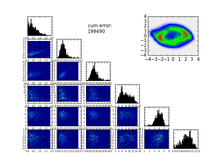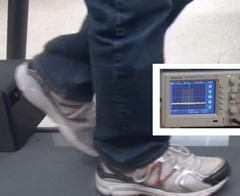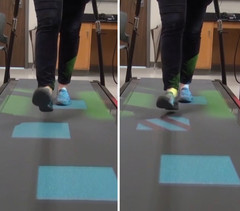Gait Phase Modulated Deep Brain Stimulation
Deep brain stimulation is ordinarily delivered in a constant, unvarying, unmodulated manner. We are testing, in humans, a novel form of DBS in which the stimulation is modulated with the gait cycle.
Test stimulation being delivered in synch with gait cycle (experimental mockup, with un-implanted neurostimulator).
Gait and Obstacle Avoidance
Gait impairment is one of the most serious Parkinson's symptoms. Abnormalities (such as shortened stride, and altered stride-length / gait-speed relationship) are apparent even with straight-ahead walking on a flat, featureles surface, as in usual laboratory gait testing. But real-world gait requres constant adaptation to the environment. We found that Parkinson's patients are measurably slower in adapting their gait to avoid virtual obstacles which appear suddenly at varying times. We are examining how this varies with disease-stage, and plan to study how it's affected by DBS.
Virtual stepping stones projected onto treadmill; Virtual obstacle appears suddenly.
Fitting Models of Parkinson's Rhythmical Movements Using a Particle Filter

Patients with Parkinson's disease exhibit characteristic abnormalities of rhythmical movements known as "hastening" or "festination" in which frequency is pathologically increased. Rhythmical finger-tapping (MDS-UPDRS item 3.4) is used clinically to quantify these abnormalities. A successful model of the dynamics of Parkinsonian rhythmical movements could serve as the basis for closed loop deep brain stimulation for treatment-refractory symptoms affecting rhythmical activities of daily living such as speech and gait.
We constructed two models of Parkinson's finger-tapping dynamics, one with a single stable limit cycle attractor (single-basin model), and the other with two stable limit cycle attractors, representing normal and festinating movements (double-basin model). In 29 Parkinson's patients and 20 control patients performing finger-tapping we measured motion of the proximal thumb and index finger with angular velocity transducers. We fit the models to the data using a particle filter, assessing goodness of fit by cross-validation. We are interested in comparing goodness-of-fit between the single- and double-basin models in Parkinson's and control subjects, to assess the the filter for detecting transitions between normal and festinating regimes.
Double-basin model: Conditional probability distribution of model parameters as fit by particle filter to patient data. Multidimensional distribution projected onto one- and two-dimensional subspaces.

